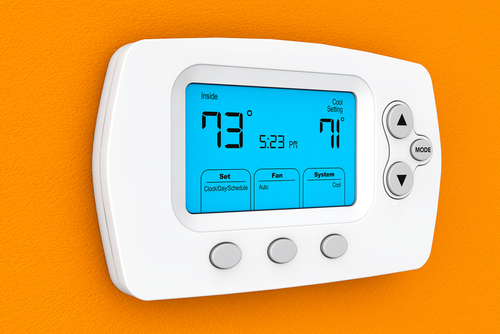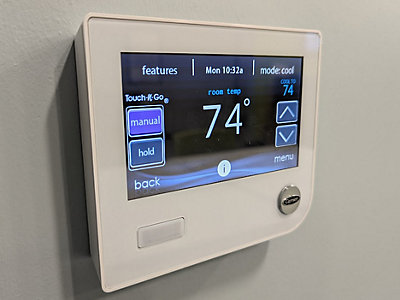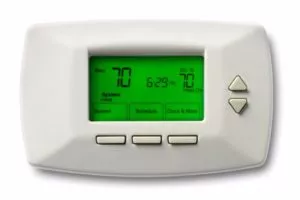Check Best Thermostat Pricing in Amazon
** As an Amazon Associate, I earn from qualifying purchases.
The fan setting on a thermostat controls the blower fan of your HVAC system. It determines when the fan operates.
The fan setting typically includes options like “On,” “Auto,” and sometimes “Circulate. ” Setting it to “On” means the fan runs continuously, providing constant air circulation throughout your home. This can help maintain even temperatures and improve indoor air quality by constantly filtering the air.
The “Auto” setting runs the fan only when heating or cooling is active, which can save energy and reduce wear on the fan motor. Some thermostats also offer a “Circulate” option, which runs the fan intermittently to balance air circulation and energy efficiency. Choosing the right fan setting can enhance comfort and efficiency in your home.

Credit: www.brennanshvac.com
- Introduction To Fan Settings On Thermostats
- Auto Vs. On: Decoding The Fan Modes
- Energy Efficiency And Fan Settings
- Comfort Considerations
- Maintenance And The Fan Setting
- Advanced Thermostat Features
- Troubleshooting Common Fan Issues
- Making The Right Choice For Your Home
- Frequently Asked Questions
- Conclusion
Introduction To Fan Settings On Thermostats
The fan setting on a thermostat controls how the fan operates in your HVAC system. It is a simple yet important feature. Understanding these settings can help you manage your home’s comfort and energy efficiency.
The Role Of The Fan In Hvac Systems
The fan in an HVAC system helps circulate air throughout your home. This ensures that the temperature is consistent in every room. It also helps in improving indoor air quality by moving air through filters.
Types Of Fan Settings Available
There are usually two main fan settings on thermostats:
- Auto: The fan runs only when the heating or cooling system is on. This setting saves energy.
- On: The fan runs continuously, regardless of whether heating or cooling is active. This setting can improve air circulation but uses more energy.
| Setting | Description | Energy Use |
|---|---|---|
| Auto | Fan runs only with heating or cooling. | Low |
| On | Fan runs continuously. | High |
Choosing the right fan setting depends on your needs. If energy efficiency is important, select the Auto setting. If constant air circulation is needed, the On setting is better.
Auto Vs. On: Decoding The Fan Modes
Understanding the fan settings on your thermostat can optimize your home’s comfort and efficiency. The two primary modes are “Auto” and “On”. Each has its unique benefits and drawbacks. Let’s decode these fan modes to see which one suits your needs best.
Pros And Cons Of Auto Mode
Auto mode automatically turns the fan on when the system is heating or cooling. It turns off once the desired temperature is reached.
| Pros | Cons |
|---|---|
|
|
Pros And Cons Of On Mode
In On mode, the fan runs continuously, regardless of heating or cooling cycles.
| Pros | Cons |
|---|---|
|
|
Energy Efficiency And Fan Settings
Understanding the fan setting on your thermostat can greatly impact your home’s energy efficiency. Adjusting the fan settings correctly can help save on utility bills. Let’s dive into how these settings affect energy use and how to optimize them for savings.
Impact On Utility Bills
The fan setting on your thermostat controls how air circulates in your home. There are usually two options: Auto and On. The Auto setting runs the fan only when the heating or cooling system is on. The On setting keeps the fan running continuously.
Auto mode is more energy-efficient. The fan only runs when needed, reducing energy use. This translates to lower utility bills. In contrast, the On mode can lead to higher energy consumption and increased costs.
Here’s a quick comparison:
| Setting | Energy Use | Impact on Bills |
|---|---|---|
| Auto | Lower | Saves Money |
| On | Higher | Costs More |
Optimizing Your Thermostat For Savings
Optimizing your thermostat settings can maximize energy savings. Here are some tips to help you:
- Use the Auto setting to reduce energy use.
- Set a programmable schedule to automatically adjust temperatures based on your routine.
- Keep your thermostat at a consistent temperature for better efficiency.
- Regularly maintain your HVAC system to ensure it runs efficiently.
By following these tips, you can achieve significant savings on your utility bills. Proper fan settings and maintenance are key to energy efficiency.

Credit: buckeyeheat.com
Comfort Considerations
Understanding the fan setting on your thermostat can greatly impact your home’s comfort. It’s more than just a simple switch. It can influence temperature consistency, air quality, and energy efficiency. Let’s dive into how the fan setting affects your comfort.
Maintaining Consistent Temperatures
The fan setting can help maintain consistent temperatures throughout your home. When the fan is set to “On,” it runs continuously. This can help spread cool or warm air evenly. This means no more hot or cold spots in different rooms.
In contrast, setting the fan to “Auto” means it only runs when the system is heating or cooling. This can lead to more significant temperature swings. It may be less comfortable for sensitive individuals.
Air Quality And Circulation
Running the fan continuously can improve air quality by constantly circulating air through filters. This helps remove dust, pollen, and other particles. For allergy sufferers, this can make a big difference.
Continuous circulation also helps distribute fresh air from open windows or ventilation systems. This can reduce stuffiness and improve overall air quality. On the other hand, the “Auto” setting may not circulate air as effectively. This can lead to stale air and higher pollutant levels.
| Fan Setting | Temperature Consistency | Air Quality |
|---|---|---|
| On | More consistent | Better air circulation |
| Auto | Less consistent | Less effective circulation |
In summary, the fan setting on your thermostat plays a crucial role in your home’s comfort. Whether it’s maintaining even temperatures or improving air quality, understanding these settings can lead to a more comfortable living environment.
Maintenance And The Fan Setting
The fan setting on your thermostat plays a crucial role in maintaining your HVAC system. Proper use and maintenance can extend your system’s life and improve efficiency.
Filter Lifespan And Fan Usage
The fan setting affects your filter’s lifespan. There are two primary fan settings: “Auto” and “On”. The “Auto” setting runs the fan only when the system is heating or cooling. The “On” setting keeps the fan running continuously.
Running the fan continuously can keep the air cleaner, but it also means the filter gets dirty faster. Ensure you check and replace your filter more often if you use the “On” setting. A clean filter improves air quality and system efficiency.
Check Best Thermostat Pricing in Amazon
** As an Amazon Associate, I earn from qualifying purchases.
| Fan Setting | Filter Change Frequency |
|---|---|
| Auto | Every 1-3 months |
| On | Every month |
Regularly inspecting the filter is essential. A clogged filter makes your system work harder, increasing energy usage and wear.
Regular Hvac System Servicing
Regular servicing keeps your HVAC system in top shape. Schedule a professional check-up at least twice a year. This ensures all components, including the fan, are working correctly.
During servicing, technicians will:
- Inspect and clean the fan
- Check for any wear and tear
- Lubricate moving parts
- Test system performance
These steps help in identifying potential issues early. Regular maintenance prevents costly repairs and ensures your system runs efficiently.
Using the thermostat’s fan setting wisely and regular servicing can extend your HVAC system’s life. Keep your home comfortable and energy-efficient by following these simple maintenance tips.
Advanced Thermostat Features
Understanding the advanced thermostat features can make your home more comfortable. These features offer better control over your home’s climate. One key feature is the fan setting on your thermostat.
Programmable Thermostats And Fan Control
Programmable thermostats allow you to set a schedule for your heating and cooling. This helps in saving energy and money. The fan control on these thermostats lets you choose when the fan runs.
- On Mode: The fan runs continuously. It helps in even air distribution.
- Auto Mode: The fan runs only when heating or cooling is active. It saves energy.
- Circulate Mode: The fan runs intermittently. It balances air quality and energy use.
Smart Thermostats: Remote Access And Monitoring
Smart thermostats offer remote access and monitoring. You can control your thermostat using a smartphone app. This means you can adjust settings from anywhere.
These thermostats also provide detailed insights into your energy usage. Some models even learn your habits and adjust settings automatically. This makes your home even more efficient.
| Feature | Benefits |
|---|---|
| Remote Access | Change settings from anywhere. Increase convenience and control. |
| Energy Reports | Understand your usage. Make informed decisions to save money. |
| Learning Algorithms | Thermostat adapts to your schedule. Enhances comfort and efficiency. |
Troubleshooting Common Fan Issues
Understanding the fan setting on your thermostat can be tricky. Sometimes, your fan might not work as expected. This guide helps you fix common fan issues.
When The Fan Won’t Turn Off
Your fan should turn off when your system isn’t heating or cooling. If it keeps running, it might be set to “On” instead of “Auto.”
- Check your thermostat settings. Make sure the fan is set to “Auto.”
- Inspect the wiring. Loose wires can cause the fan to run constantly.
- Look at the fan relay switch. A stuck switch can keep the fan running.
If these steps don’t help, you may need to call a technician. They can check for more serious issues.
When The Fan Won’t Turn On
Sometimes, your fan won’t start when it should. This can make your home uncomfortable.
- Check the thermostat settings. Ensure it’s not set to “Off.”
- Look at the circuit breaker. A tripped breaker can cut power to the fan.
- Inspect the fan motor. A broken motor won’t run.
If the fan still won’t turn on, you might need to replace the motor. A technician can help you with this.
| Issue | Possible Causes | Solutions |
|---|---|---|
| Fan Won’t Turn Off | Wrong setting, loose wiring, stuck relay switch | Set to “Auto”, check wiring, inspect relay switch |
| Fan Won’t Turn On | Wrong setting, tripped breaker, broken motor | Set to “Auto”, reset breaker, check motor |
Making The Right Choice For Your Home
Choosing the right fan setting on your thermostat can make your home comfortable. It can also save you money. Understanding your options is essential. Let’s explore how to make the best decision.
Assessing Your Hvac Needs
Start by evaluating your home’s heating and cooling needs. Consider the following:
- Climate: Is your area hot, cold, or moderate?
- Home Size: Larger homes may need more powerful systems.
- Energy Efficiency: Do you want to save on energy bills?
Think about your lifestyle. Do you spend most of your time at home? This can influence your choice.
Consulting With Hvac Professionals
Experts can help you decide on the best fan setting. They understand different systems and can offer tailored advice. Consider the following points:
- Ask about the benefits of each setting (Auto vs On).
- Request a system check-up to ensure everything works well.
- Get advice on energy-saving tips for your system.
Professionals can also help you understand your thermostat. They can show you how to use it efficiently.

Credit: www.homeofintegrity.com
Frequently Asked Questions
What Should The Fan Setting Be On A Thermostat?
Set the thermostat fan to “Auto” for energy efficiency. Use “On” for continuous circulation and better air quality.
Is It Ok To Leave Thermostat Fan On?
Yes, it is generally OK to leave the thermostat fan on. It helps circulate air and maintain temperature. This can improve comfort and air quality. However, it might increase energy costs.
Should My Ac Fan Be On Auto Or Circulate?
Set your AC fan to “auto” for energy efficiency. Use “circulate” to improve air quality and even temperature distribution.
Should The Fan Be On Auto Or On In Winter?
Set the fan to “auto” in winter. It conserves energy and maintains consistent indoor temperatures.
Conclusion
Understanding the fan setting on your thermostat can save energy and improve comfort. Use it to balance airflow and maintain consistent temperatures. Proper use extends HVAC system life and reduces utility bills. Experiment with different settings to find what works best for your home.
Optimize your indoor environment and enjoy the benefits today.
Check Best Thermostat Pricing in Amazon
** As an Amazon Associate, I earn from qualifying purchases.


